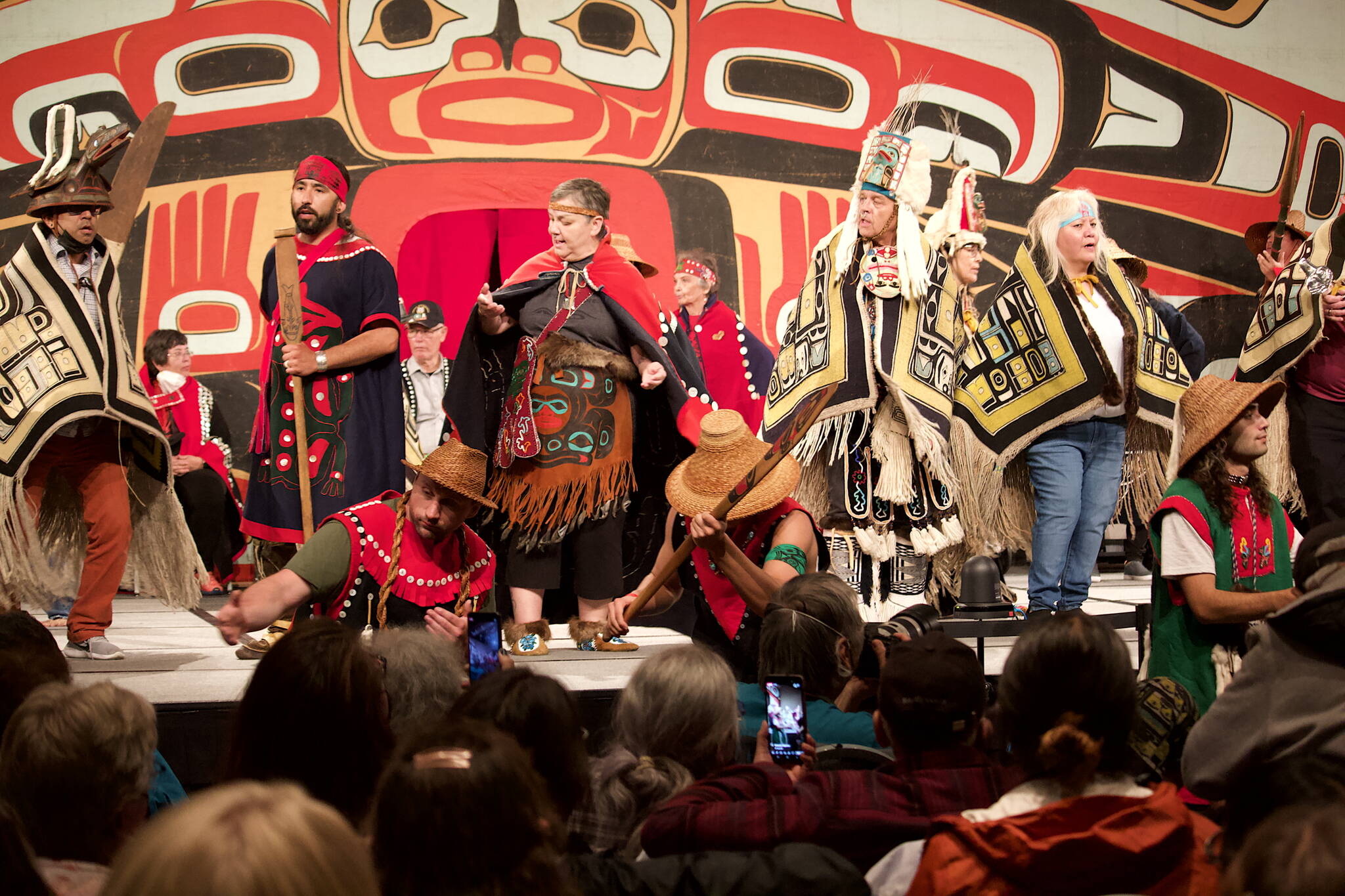An earlier version of this story incorrectly attributed statements by Tlingit and Haida Business Corp. CEO Richard Rinehart to Sealaska Heritage Institute Development Committee Chair Nathan McCowan. It has been updated to correct the attribution.
For people long accustomed to facing and overcoming hardship together, finding the spirit to end Celebration loud and proud came naturally.
“Didn’t you see the strength of our people?” Rosita K̲aaháni Worl, president of Sealaska Heritage Institute and the de facto emcee throughout the week, asked rhetorically with pride after a 90-minute Grand Exit dance by this year’s 1,200 participants at Centennial Hall. “Didn‘t you see the power of our drummers? Didn’t you see the beauty of our women? Didn’t you see the smiles of pride on our children? Haven’t we come a long way from 40 years ago when we had our first Celebration?”
While the number of participants was smaller than the estimated 2,000 at the last in-person Celebration in 2018, the enthusiasm and endurance this year was evident by, among other things, the performers repeating the same dance for the Grand Entrance on Wednesday. Richard Rinehart, CEO for Tlingit and Haida Business Corp., said after long consideration they decided more traditional Grand Exit would have take far longer than the standing-room-only audience might be prepared for.
For many participants, the most memorable part of the four-day event is simply that it happened after being reduced to a virtual event in 2020 due to the COVID-19 pandemic.
“I understand a lot of people didn’t come here to be safe,” said Kyle Johnson Sr., 42, an Angoon resident among the roughly 40 participants with the Xudzidaa Kwáan Dancers, who has been attending Celebration since the age of 5. “But being here was the most amazing thing.”
He said the gathering, while striving to preserve and honor traditions that are thousands of years old, also is changing over the years in ways that hopefully will keep those customs thriving.
“The culture seems to be progressing,” Johnson said, “We’re coming up with new songs to adapt, kind of like the pop culture in today’s world. I would say that’s a good thing because it’s going to bring in the younger generation.”
A modern cultural change, possibly inspired by the disruptions caused by the pandemic, was also evident to Barbara Searls, a Juneau resident and Celebration participant since 1992 who said this year’s dance Eagle-Raven group participants showed a remarkable embrace of diversity.
“We had new dancers with our group, young men,” she said. “Normally, we have to beg them. They’re so busy at their summer jobs and just life, and maybe don’t recognize the importance of the culture. I think they realized how important it is to come forward.”
As those speaking during the close referred to events like Celebration keeping their culture thriving for the next 17,000 years, many are already eyeing the more immediate next steps of that future.
Worl said Sealaska organizers will get two days of rest before beginning to plan the 2024 Celebration. Rinehart said he’s hopping on a jet Sunday morning to Washington, D.C., to lobby members of Congress on a pending bill granting Native corporation land entitlement rights to five Southeast Alaska communities not included in the Alaska Native Claims Settlement Act.
The Grand Exit was preceded with the premiere screening of the hour-long documentary “Celebration,” featuring video and narration from Natives participating in the gatherings since the first one in 1982.
The videos of the first event of seemingly few people on a humbly adorned small stage are a striking contrast to modern times, with those who’ve been a part of Celebration since its inception noting it’s grown from a secular dance gathering to a landmark event featuring canoe arrivals, totem raisings and all aspects of the region’s Native cultures.
Brian Wallace, a former Juneau Empire photographer who has been the official photographer for Celebration’s group picture since 2010, said during a portion of the film focusing on those shots they serve as both a valuable and painful memento.
“Looking at the photos, it’s kind of heartbreaking because you see all the elders who are no longer with us,” he said.
But Wallace said he embraces the idea of future generations experiencing those feelings for a long time to come.
“I hope Celebration goes on for the next 500, 600, 700 years,” he said.
Juneau Empire reporter Mark Sabbatini can be reached at mark.sabbatini@juneauempire.com

